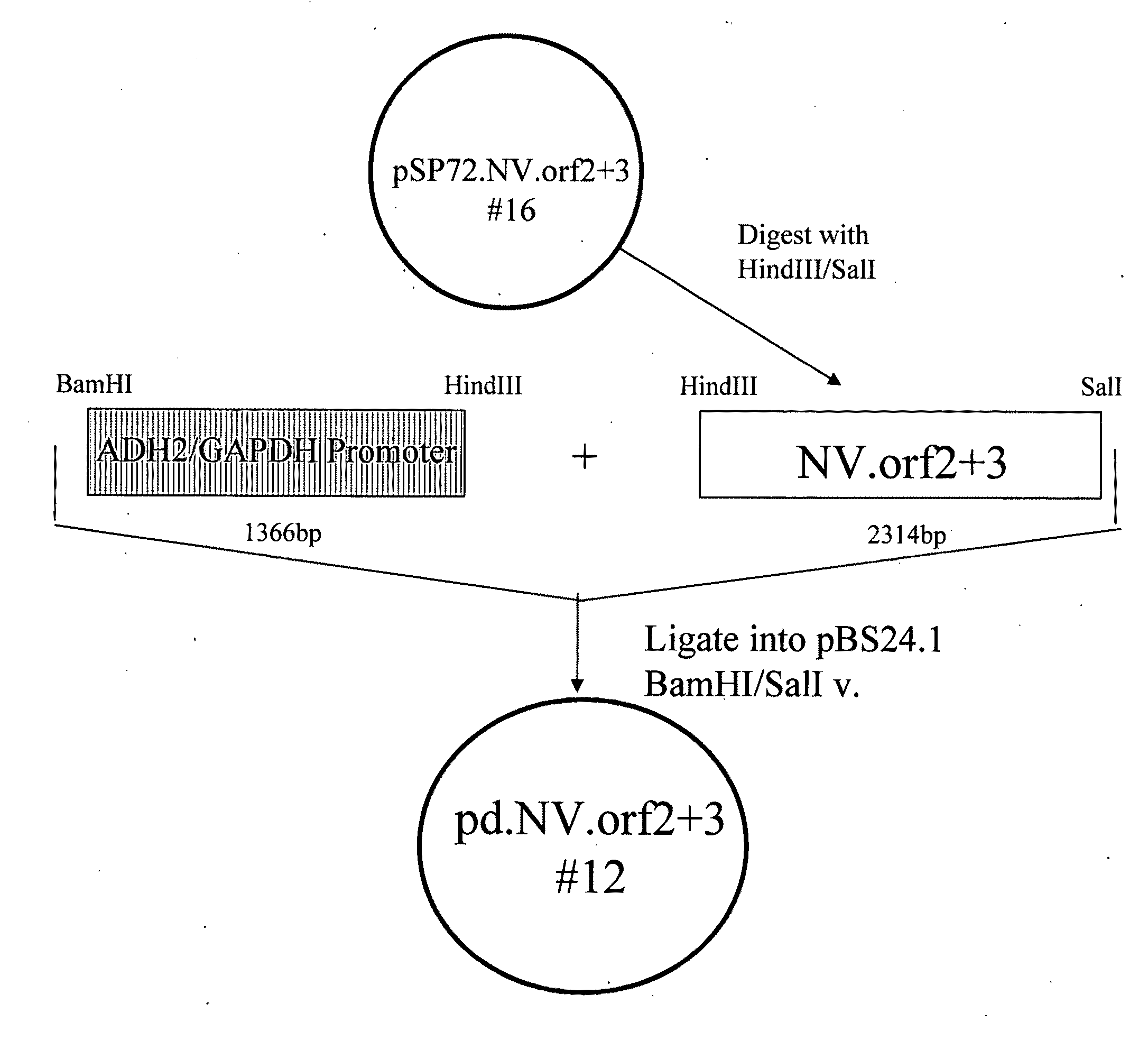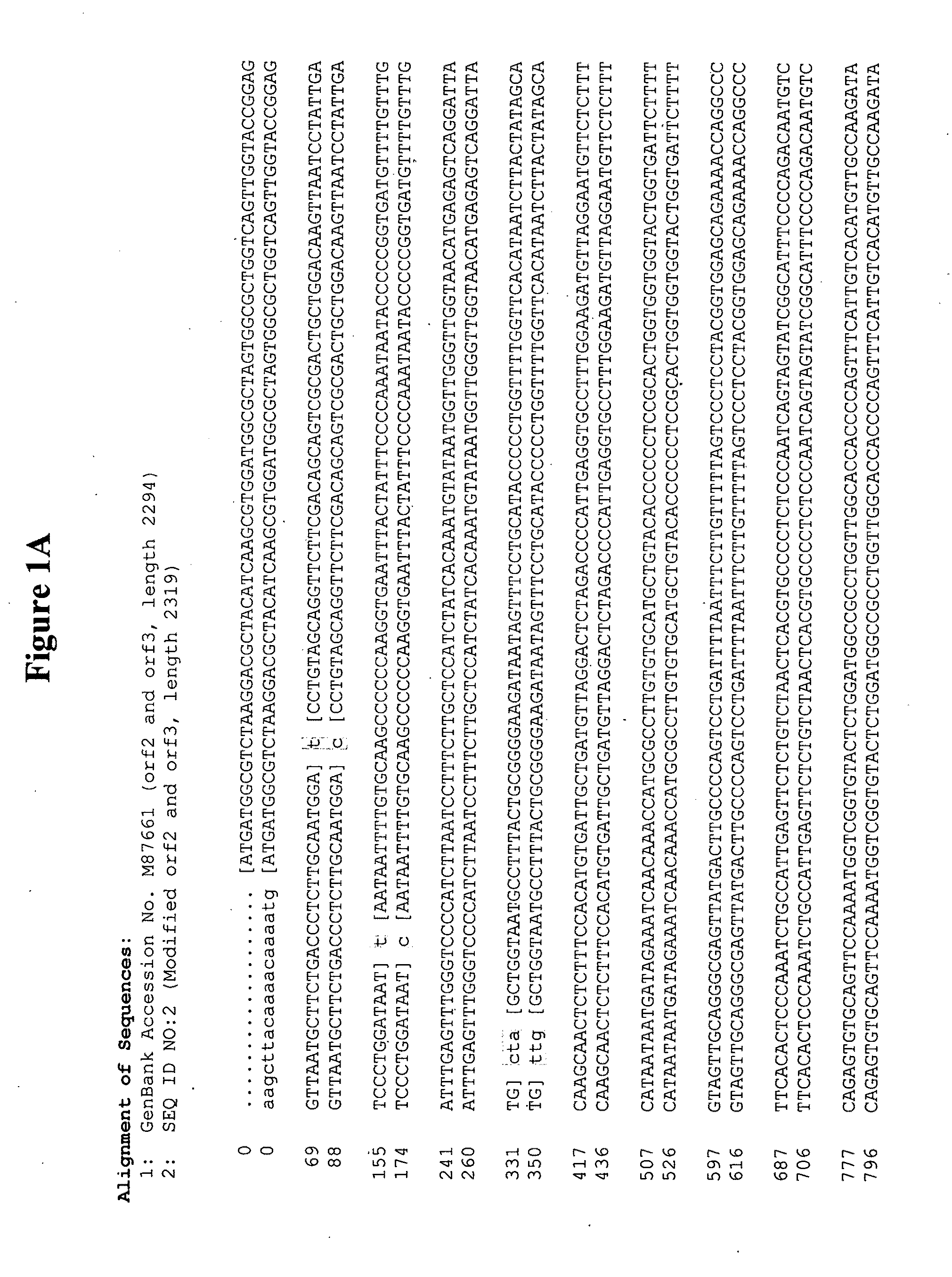Norovirus and sapovirus antigens
a technology which is applied in the field of sapovirus and sapovirus antigens, can solve problems such as ion transfer interferen
- Summary
- Abstract
- Description
- Claims
- Application Information
AI Technical Summary
Problems solved by technology
Method used
Image
Examples
example 1
Expression of Norwalk Virus Capsid Protein in Yeast
[0665]Constructs for production of Norwalk virus (NV) VLPs in Saccharomyces cerevisiae were created by cloning sequences encoding viral capsid proteins into the yeast expression vector pBS24.1. The pBS24.1 vector is described in detail in commonly owned U.S. patent application Ser. No. 382,805, filed Jul. 19, 1989, which application is hereby incorporated by reference in its entirety herein. The pBS24.1 vector contains the 2μ sequence for autonomous replication in yeast and the yeast genes leu2d and URA3 as selectable markers. The β-lactamase gene and the ColE1 origin of replication, required for plasmid replication in bacteria, are also present in this expression vector. Regulation of expression was put under the control of a hybrid ADH2 / GAPDH promoter (described in U.S. Pat. No. 6,183,985) and an alpha-factor terminator.
[0666]The constructs created and utilized for expression of NV capsid proteins included: NV.orf2 comprising a mo...
example 2
Expression of Norwalk Virus Capsid Protein in Insect Cells
[0676]For the expression of NV capsid orf2 and NV capsid orf2+3 in the insect cell system, the following manipulations were undertaken to create an NheI / SalI fragment that could be cloned into PBLUEBAC4.5 baculovirus expression vector. First, the 5′ end of the orf2 and orf2+3 HindIII / SalI fragments were modified to replace the HindIII restriction site with a NheI restriction site. This was accomplished with a 63 by synthetic oligo that included the NheI site at the beginning, a sequence encoding amino acids 1-21 of the capsid protein, and a KpnI site at the end. Next, a 1534 by KpnI / SalI NV.orf2 fragment and a 2235 by KpnI / SalI NV.orf2+3 fragment were isolated by digesting pSP72.NV.orf2 #1 and pSP72.NV.orf2+3 #16, respectively, with KpnI and SalI followed by gel electrophoretic separation and purification of the isolated bands. The NheI / KpnI oligos and the KpnI / SalI fragments were ligated into the PCET906A shuttle vector (ML ...
example 3
Production of a Multiepitope Fusion Protein
[0679]A polynucleotide encoding an Nterm-NTPase fusion, comprising approximately amino acids 1 to 696, numbered relative to Norovirus MD145-12 (SEQ ID NO:13), is isolated from a Norovirus. This construct is fused with a polynucleotide encoding a polymerase polypeptide which includes approximately amino acids 1190-1699 of the polyprotein numbered relative to Norovirus MD145-12. The polymerase-encoding polynucleotide sequence is fused downstream from the Nterm-NTPase-encoding portion of the construct such that the resulting fusion protein includes the polymerase polypeptide at its C-terminus. The construct is cloned into plasmid, vaccinia virus, adenovirus, alphavirus, and yeast vectors. Additionally, the construct is inserted into a recombinant expression vector and used to transform host cells to produce the Nterm-NTPase-Pol fusion protein.
PUM
| Property | Measurement | Unit |
|---|---|---|
| diameter | aaaaa | aaaaa |
| concentration | aaaaa | aaaaa |
| diameter | aaaaa | aaaaa |
Abstract
Description
Claims
Application Information
 Login to View More
Login to View More - R&D Engineer
- R&D Manager
- IP Professional
- Industry Leading Data Capabilities
- Powerful AI technology
- Patent DNA Extraction
Browse by: Latest US Patents, China's latest patents, Technical Efficacy Thesaurus, Application Domain, Technology Topic, Popular Technical Reports.
© 2024 PatSnap. All rights reserved.Legal|Privacy policy|Modern Slavery Act Transparency Statement|Sitemap|About US| Contact US: help@patsnap.com










